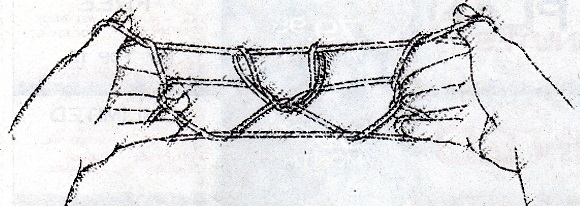Saad Bee Ál’íní (Alphabet)
A, B, Ch, Ch’, D, Dl, Dz, E, G, Gh, H, Hw, I, J, K, K’, Kw, L, Ł,
M, N, O, S, Sh, T, T’, Tł, Ts, Ts’, W, X, Y, Z, Zh, ’ (glottal stop)
|
|
Yá’át’ééh Marilyn Dempsey dashijní. Kiiyaa’áanii nishłí̜. Tó Dích’íi’nii báshíshchíín. Dibéłzhíní éí dashicheii. Hónágháahnii éí dashinálí. Kót’éego asdzá̜á̜ nishłí̜.

The Diné Bizaad page’s purpose is to provide an introduction to our indigenous language. Our language has been spoken by our people throughout time to communicate with one another, to sing, to pray, to express thoughts, and to think, plan, live, and reflect on our lives. Our great grandfather and leader, Chief Manuelito was quoted, “Shikéí, shidine’é, ałtah háási̜i̜łgóó… háadida léi’ nihizaad, nihisodizin, ádóone’é niidlínígíí dóó nihe’á’ál’í̜ nihił ch’aa wóle’ sha’áłchíní, hosídoolí̜i̜ji̜’, sidoołdee’ji̜’…” His words should not be forgotten and left by the wayside. So, it is up to each one of us to revitalize and maintain our dying language.
Indigenous languages have been utilized in wars of the United States. Our Diné language was used to win a war for this country. Just as the Code Talkers used our language as a weapon, we too must use our language as a weapon to protect our Diné Culture and values.
Diné Bizaad is one of the few indigenous languages left. We have not lost it all yet. Out of hundreds of indigenous languages pre-Columbus, there are less than 100 indigenous languages left that are spoken today.
Language is essential to the survival of a culture. Language and culture is essential to one’s self-identity, self-esteem, foundation, and success in life.
|
Tł’óół Bee Na’atł’o’
|
Haigo éí Diné bighan góne’ nidaanée łeh. Na’atł’o’ éí haigo bee nidajiné. Ałk’idá̜á̜’ Diné baa hane’ éí Na’ashjé’ii Dine’é na’atł’o’. Diné yaa deideez’á̜ jiní. Na’atł’o’ éí hóyáanii dóó áłchíní yee nida’atł’o’. Na’atł’o’ éí so̜’ dóó naaldlooshii dóó t’áadoo le’é áł’a̜a̜ ádaat’éego bee ádajił’í̜.
Na’atł’o’ éí haigo t’éiyá bee nida’jitł’o’. Haigo éí Na’ashjé’ii Dine’é dóó Na’ashó̜’ii Dine’é dóó Ii’ni’ Dine’é da’ałhosh dóó naaldlooshii ła’ ałdó’ da’ałhosh łeh biniinaa haigo t’éiyá tł’óół bee nida’jitł’o’. Shí̜i̜go tł’óół bee ni’jitł’o’go éí na’ashjé’ii bitł’óól hála’ yik’ídídis jiní.
Tł’óół t’éiyá choo’í̜ na’atł’o’ biniiyé. Tł’óół éí be’jitł’óóh. Hála’ t’áá áłah halázhoozh tł’óół bit’a’ naazt’i̜’go bee na’atł’o’. Hála’ nitsaago éí nineezgo ájiił’i̜i̜h. Hála’ áłts’íísígo éí tł’óół áłts’íísígo ájiił’i̜i̜h. Áłchíní éí tł’óół áłts’íísígo bá yá’át’ééh.
Tł’óół éí doo t’óó daane’é át’ée da. Na’atł’o’ éí hane’ ba̜a̜h dahóló̜. Na’atł’o’ so̜’ bee ádaalyaaígíí éí hane’ ba̜a̜h dahóló̜. Naaldlooshii dóó nahasdzáán ałdó’ baa hane’. Hane’ígíí binahji̜’ éí iiná bik’izhdiiti̜i̜h.
Ałk’idá̜á̜’ Ni’haltsodi éí Na’ashjé’ii Dine’é kéédaahat’íí nít’éé’ jiní. Na’ashjé’ii Asdzá̜á̜ éí tł’óół yoołgai nidik’a̜’áłgai wolyéego áyiilaa jiní. Áko éí díísh jí̜i̜di éí Diné chodayooł’í̜. Tł’óół bee na’atł’o’ dóó tł’óół bee atł’óogo choo’í̜. Tł’óół bee nijitł’o’go éí So̜’ Tsoh átsé ájiił’i̜ih. So̜’ Tsoh éí nitsáhákees bá. So̜’ Tsoh ájiił’i̜ihgo biníkázhdí’i̜i̜h. Áádé̜é̜’ so̜’ hanitsáhákees yi’diłdla’ dóó nitsáhákees yá’át’éhígíí há yi’diłdla’ jiní. Nitsáhákees doo yá’ádaat’éhígíí éí nahji̜’ kóyiił’i̜i̜h. Áádóó Dilyéhé éí shádá’áahjigo bá. So̜’ Łání éí e’e’aahjigo bá. Náhooko̜sjigo éí So̜’ Bidee’í. Díí t’áá ałtso ałkéé’ ádajiił’i̜i̜hgo dóó biníká jidí’i̜i̜h. Éí bikéédóó índa t’áá hó jinízinígíí nijitł’o’ łeh.

|
Fill in the blanks with words about the string game.
(Answers will be in next week’s issue.)
|
|
1. __________ éí Diné bighan góne’ nidaanée łeh.
2. __________ na’atł’o’ Diné yaa deideez’á̜.
3. Na’atł’o’ éí __________ t’éiyá bee nijda’jitł’o’.
4. Áłchíní éí __________ áłts’íísígo bá yá’át’ééh.
5. Na’atł’o’ éí __________ ba̜a̜h dahóló̜.
6. __________ éí tł’óół yoołgai nidik’a̜’áłgai wolyéego
áyiilaa.
7. tł’óół bee nijitł’o’go éí __________ átsé ájiił’i̜i̜h.
8. __________ éí shádí’áahjigo bá.
9. __________ éí e’e’aahjigo bá.
10. Náhooko̜sjigo éí __________.
|
Translation answers from last week’s puzzle:
1. Gólizhii – skunk; night
2. Shash – bear; night
3. Dló̜ó̜’ – prarie dog; day
4. Náshdóí – wildcat; day
5. Dah Sání – porcupine; night
6. Gah – rabbit; day
7. Né’éshjaa’ – owl; night
8. Bi̜i̜h – deer; day
9. Jaa’abání – bat; night
10. Yé’ii Tsoh – giant; day
11. Na’azísí – gopher; day
12. Ma’ii – coyote; day and night
|
|
